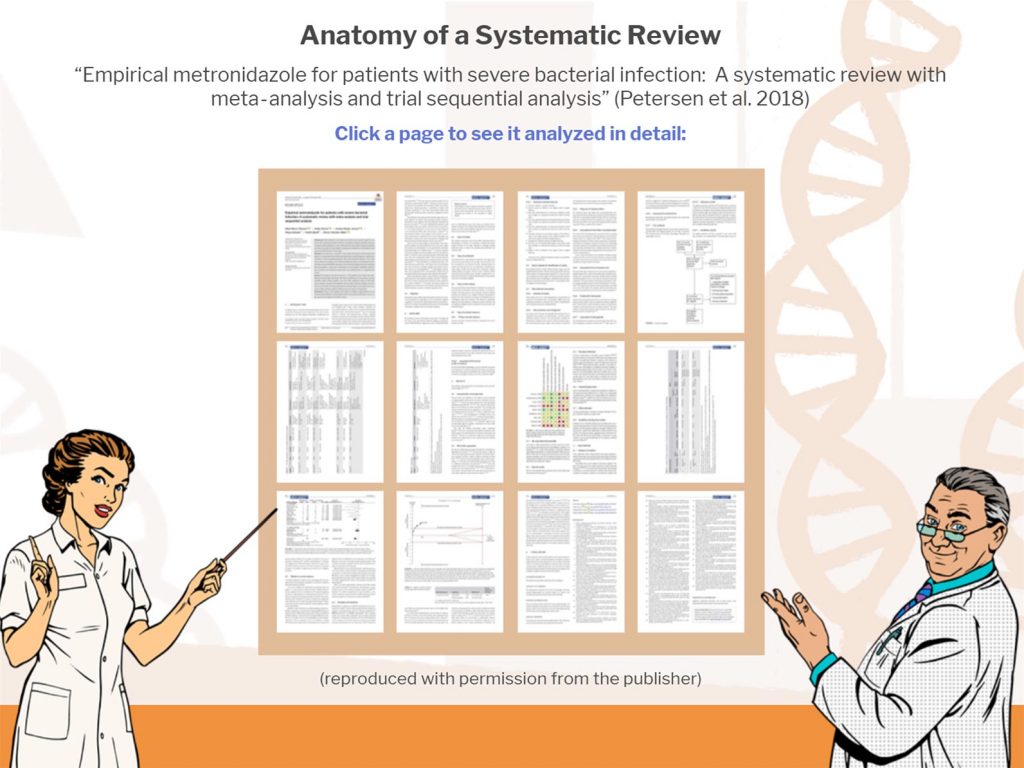The forest plot is a figure that appears in the Results section of a systematic literature review. It’s a graphic representation of the findings of multiple studies that investigated the same scientific question and measured the same outcome.
What you’ll learn in this post
• What a forest plot is within a systematic literature review (SLR).
• How this relatively simple diagram shows the findings covered in the review.
• A sample forest plots and explanation of what it specifically shows.
• How to interpret a forest plot and where to use it in your own SLR.
• Approaches for creating your own forest plot and developing your SLR, or getting expert help to speed along the process.
Where is a forest plot used?
In a systematic review of clinical trials, for example, the forest plot shows whether the intervention/new drug is more effective than the control/standard treatment. The effectiveness is expressed as the outcome measure: elimination of the pathogen from the body, recovery from the disease, or discharge from the hospital within a set number of days.
In a systematic review of epidemiological studies, the forest plot shows whether the exposure (e.g., smoking, alcohol, inhaling high levels of air pollutants, obesity) is likely to be a cause of the outcome measure (e.g., development of a medical condition). The exposure can also be a variable that is not environmental—for instance age, sex, ethnicity, or a gene allele.
The findings of each study are plotted as one dot or square, enabling readers to obtain a visual impression of similarities and differences in findings between studies. The horizontal location of the dot or square on the graph represents the measure of the effect.
Example forest plot
Take a look at this example forest plot (with fictional data), where the research question was: “Does smoking contribute to the development of atrial fibrillation?”

The space in a forest plot is divided vertically into two segments. The solid dividing line means “no effect.” One segment represents the experimental variable and the other segment represents the control. The results of each study are expressed as a square, and the location of the square indicates the findings of the primary study. The measure of effect can be expressed in a forest plot as an odds ratio, risk ratio, or relative risk.
This forest plot is an assessment of studies that compared the odds of developing atrial fibrillation by smoking status. Each blue square represents the odds ratio of developing atrial fibrillation, as calculated for each study and listed in the column “OR” on the right. The study’s first author and year of publication appear on the left. The size of the blue square indicates the weight of the study in the meta-analysis (see the “WGHT” column on the right).
The bars to the left and right of each blue square represent the lower and upper confidence limits (LCL and UCL, respectively), typically of the 95% confidence interval, and the actual values are listed on the right.The pooled odds ratio is represented by the dashed vertical line and red diamond.
The left and right points of the diamond indicate the confidence limits. By pooling the cohorts and findings from the primary studies and assigning them their relative weights, the systematic review can calculate a numeric finding that is more robust than the findings of each primary study. The forest plot is a visual representation of the main finding of the systematic review.
The 12P Method for Systematic Reviews
We’ve squeezed all the steps and stages of a typical systematic review onto one page.
You can print it out A4-sized and use it as a handy checklist, or A3-sized for your laboratory wall. You can even share it with your co-authors.
Interpreting the forest plot
In our forest plot, two of the studies have confidence limits that cross the vertical line of no effect (for an odds ratio, that is a value of 1). This indicates that the effect sizes calculated by McCleary et al. (0.79–2.32) and by Iguchi et al. (0.43–1.4) may not differ from “no effect,” and should be considered inconclusive.
Similarly, the lower confidence limit of our red diamond crosses the vertical line of no effect. Our systematic review and meta-analysis may therefore conclude that there is no definitive connection between smoking and development of atrial fibrillation (but remember, we used fictional data!)
In red text on the left, we calculated the I2 statistic, a measure of heterogeneity that denotes the percentage of variance between the studies in our meta-analysis. When the studies are dissimilar, they are said to be heterogeneous, and their pooled data are considered less conclusive.
The heterogeneity measure in our analysis is quite high (73.1%). The most powerful study in our forest plot may be the study of Fadl and colleagues, because the confidence interval is so narrow, indicating more reliable data. However, this very narrow interval also raises an interesting question: What type of cohort did Fadl and colleagues recruit? Does selection bias account for the narrow range of their findings?
Selection bias occurs when the experimental groups differ in their baseline characteristics, especially when participants were not randomized to each group. When you conduct and write a systematic review, you will evaluate the risk of bias in each of the primary studies you review.
Log in or Create a Free Account to view this free interactive dissection of an actual published systematic review, including forest plots
When to include several forest plots
A systematic review can have more than one forest plot. In fact, you should graph a forest plot for each outcome you measure in your systematic review.
In the example forest plot above, the outcome measure is “development of atrial fibrillation.” The populations being compared are smokers and non-smokers. We can imagine that the name of this fictional systematic review is something such as “Contribution of smoking to development of atrial fibrillation: A systematic review and meta-analysis.” There is a single forest plot for the one outcome being measured.
However, if the title was “Contribution of smoking to development of cardiovascular conditions,“ we would see multiple forest plots – one for each outcome that was measured by the primary studies. In addition to the forest plot for atrial fibrillation, we would also have a forest plot for heart failure and a forest plot for hypertension.
Software makes forest plots easier to work with
Graphing the forest plot is a relatively easy task in conducting a systematic review and meta-analysis, because you are visualizing quantitative data and the graphing software makes all the calculations for you.
You can graph forest plots in many applications, such as Microsoft Excel, the R “forestplot” package, and GraphPad Prism™.
You can also find forest plot generators online. Edanz recommends this free forest plot generator hosted by Evidence Partners, makers of DistillerSR systematic review software.

Dr. Dean Meyer is a Board-certified Editor in the Life Sciences (ELS). She has a background in environmental science with a specialist interest in toxicology and public health. Her doctoral research work focused on molecular mechanisms of metal detoxification in an invertebrate model. Her other research interests include the mechanisms of toxicity and disease causation, and the occupational sources of xenobiotics and their physiological effects.
Dr. Meyer spent 8 years working at the Centers for Disease Control and Prevention in Atlanta, and has an extensive background in the areas of laboratory safety and environmental health.






